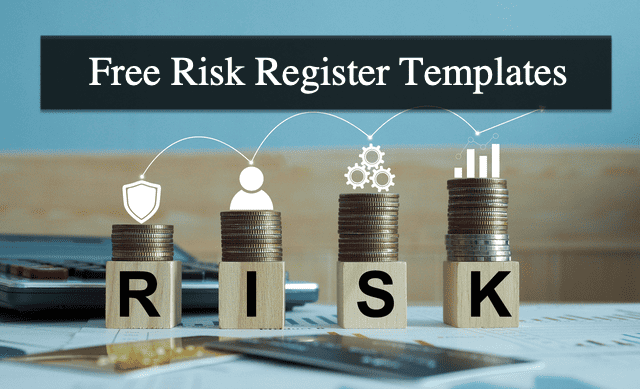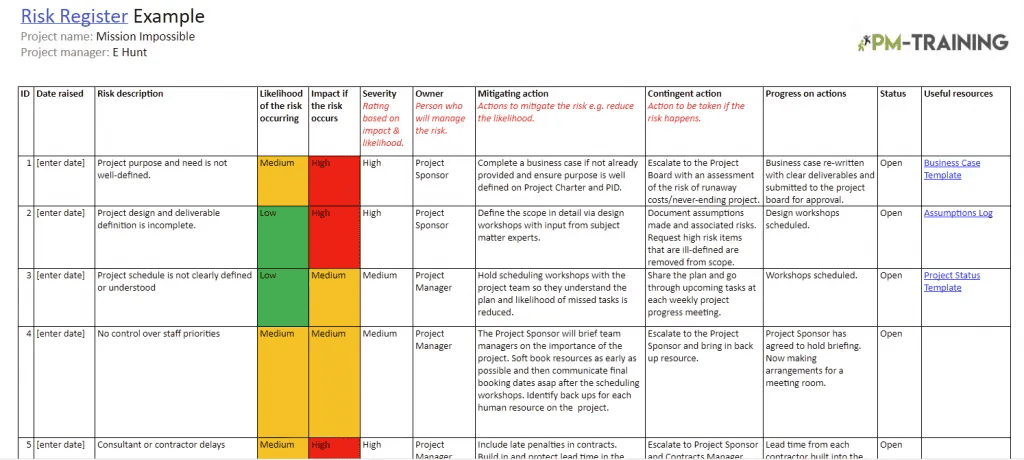
A risk register is a project management tool used to document any possible negative outcome at all stages of a goal. They are typically owned by a team leader, with each other member contributing risk data. Each risk receives a ranking determining how important it is to mitigate. These rankings can change over time and spark crucial conversations about optimizing your project for the best possible outcome.
★ Risk Register Templates serve as a foundational framework that streamlines the execution of projects. When used with project management tools, these templates enhance communication, providing a centralized platform for tracking progress.
If you need such software, don’t miss our Top 10 Best Project Management Software in 2024.
A risk register template is helpful in any project risk management plan/environment. They are never considered “finalized,” making them an excellent fit for Agile and other methodologies where circumstances change constantly. They are also ideal for brainstorming, compliance tracking, and keeping your team within scope, even in Waterfall environments or other settings where the pace is more relaxed.
Using a risk register template can help you when you are designing and executing your project. Each template is easily adaptable as your project grows and circumstances change. They can also save you time compared to designing and formatting your document or spreadsheet. Learn more about using a risk register template and explore the best online templates to get your team started.
Full PMBOK Definition on Risk Register
The risk register captures details of identified individual project risks. The results of Perform Qualitative Risk Analysis, Plan Risk Responses, Implement Risk Responses, and Monitor Risks are recorded in the risk register as those processes are conducted throughout the project. The risk register may contain limited or extensive risk information depending on project variables such as size and complexity.
11.2.3.1 PMBOK
Buy and Download our Risk Register Template – Method123

Buy and download this template to jumpstart your project immediately. By purchasing now, you also receive the “Project Management Guidebook” at no extra cost!
★ The Risk Register Template is exclusively available for purchase as part of the Project Execution Phase Template Kit. Alternatively, explore our comprehensive collection of Project Management Templates (50+ kit) designed for Project Managers.
What is the Purpose of a Risk Register?
1. Risk registers to stop scope creep
2. Risk registers help track compliance
3. Risk registers to create better communication
4. Risk registers fortify corporate security and data privacy
How to Create a Risk Register
Because risks change throughout a project, a risk register is a dynamic document. Project and team leaders must continually evaluate the total risk to adapt their register to the circumstances of each project stage.
At a minimum, your risk register should have the following elements:
- a way to quickly identify each risk, such as an ID number
- a description of each risk
- a breakdown structure allowing you to sort risks into categories
- a space to list each risk’s probability of occurring using numerical or qualitative rankings
- a priority score, which is equal to the qualitative impact of the risk times its probability
- a list of mitigation steps, usually copied from a separate document
- a list of risk owners who execute and oversee mitigation steps for a single risk
A risk register should have plenty of space for team members and risk owners to be as transparent in their descriptions as possible. This is so each colleague has all the details necessary to apply a risk to their tasks. Let’s say an electrical project has a risk contingent on the team’s access to power. Rather than describing the risk as “power out,” explain the likely cause of a future power outage and how it will impact the pertinent stage of the project: “If we lose power from the coming thunderstorm, we won’t be able to test our machine.”

After describing the risk, explain its impact on the project. “We would have to delay the machine’s launch because regulations require us to conduct two weeks of final testing.” Finally, explain mitigation steps, such as designing the device using batteries or preparing a generator.
Before we move on, here are some additional tips for making and using a risk register.
- Use the “Seven Whys.” After you state a surface-level risk, ask yourself, “Why would the risk happen?” Once you have a reason, ask yourself “why” again and again until you know why the risk is happening at its most fundamental level.
- Consider residual risk or the remaining risks after all mitigation steps are complete. This risk will be minimal with a proper risk register and action plan.
- When calculating the priority score, use a standardized scale to record qualitative risk impact from 1-10. The probability will always be a whole number from 1 to 100.
- Even though risk register templates are an excellent tool for analysis, analysis is not their primary purpose. Recording further information about each risk on a separate action plan can help you stay organized and foster team collaboration.
15 Free Risk Register Templates in Google Docs

Using real-time collaboration in Google Docs or Sheets is perhaps the easiest way for team members to work together in calculating risks. If you pair the template with your action plan, you can keep your project strategy up-to-date. However, a risk register using Google Workspace will be more simplistic and less automated than something in Excel.
- Basic Project Risk Register Example
- Community Stadium Project Risk Register Example
- Construction Risk Register Template
- Project Risk Register Template
- Project Risk Register SmartSheet Template
- Operating Risk Register Template
- Worksite Risk Register Template
- Risk Register Template Example
- Risk Register Example with Risk Matrix
- Company Risk Register Document Template
- Project Risk Register Template & Guide
- Risk Register Sample
- Hazard and Risk Register Template
- Standard Project Risk Register Example
- Sample Risk Register Template
27 Free Risk Register Templates in Google Sheets

Excel risk register templates are perfect for an optimally organized document or a project where there are expected to be a larger number of individual risks. Google Sheets’s powerful calculation feature simplifies priority score and probability calculations for rapid entry of risk information. The only con of using a Google sheet is that printability will not always be consistent.
- Company Project Risk Register Template
- Activity Level Risk Register Example & Template
- Risk Register with Severity Table Template
- Detailed Project Risk Register Template with Guide & Checklist
- Stakeholder Map Risk Register Template Example
- Simple Risk Register Template
- Risk Register Capture Template
- Risk Management Log Example
- Risk Register Tool Demo Example
- Simple Project Risk Register Template
- Risk Register for Project Department Template
- Three Levels Risk Register Template
- Basic Risk Register Template
- Project Risk Register Template with Pre-Treatment & Post-Treatment
- Risk Register Template with Qualitative Rating
- Organization Risk Register Template & Example
- Generic Risk Register Template & Example
- Management Risk Register Template
- Dairy Business Risk Register Template
- Risk Register Activity Log Template
- Project Management Risk Register Template
- Risk Assessment Worksheet Template
- Risk Register Example with Guide
- Procurement Approach Risk Register Template
- Risk Register Enterprise Tool Template
- Company Project Risk Register Template
- Risk Register Template for Project Management
2 Free Risk Register Templates in Microsoft Word
- TemplateLab 45 Risk Register Template
- Stakeholder Map – PDF, Word, and Excel versions available
8 Free Risk Register Template Microsoft Excel
- ProjectManager – Use this free Risk Tracking Template for Excel to manage your projects better.
- LeadingAgile
- Oxfordshire – Risk Register Template (xlsx)
- SmartSheet Free Excel Template: Simple safety risk register template
- BoardPro
- Project Management Docs – Manage Your Risks! Use the project Risk Register for the day-to-day management of the risks in your project
- Rocketlane Blog – How to Create a Project Risk Register [Free Template]
- SportEngland – Sport England Generic Risk Register
3 Free Risk Register Templates to Download
- Atlassian – Risk Register template
- HubsSpot – Risk Register for Excel, PDF, and Google Sheets
- SampleTemplates – FREE 10+ Project Risk Register Samples in PDF | Excel
3 Free Online Tools to Create a Risk Register Template
- Monday – Risk Register – Program Risk Register Template. Clearly manage action plans, identify risks, and mitigate potential risks seamlessly with our risk register template
- DashPivot – Risk Register template – As easy as Excel, but better
- LucidChart – Open this template and add content to customize this risk register diagram to your use case.
Shane Drumm, holding certifications in PMP®, PMI-ACP®, CSM, and LPM, is the author behind numerous articles featured here. Hailing from County Cork, Ireland, his expertise lies in implementing Agile methodologies with geographically dispersed teams for software development projects. In his leisure, he dedicates time to web development and Ironman triathlon training. Find out more about Shane on shanedrumm.com and please reach out and connect with Shane on LinkedIn.